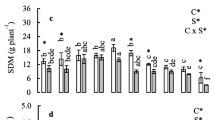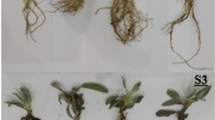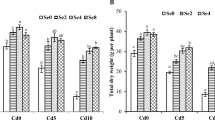Abstract
In the presented in vitro experiment, the effect of selenite treatment (0.01, 0.1, 1, 10 and 50 mg L−1 Se(IV)) on Berula erecta was investigated with respect to growth, photochemical efficiency, photosynthetic pigments, anthocyanins and low molecular weight thiols. Lower Se(IV) concentrations (0.01, 0.1 and 1 mg L−1) promoted growth, while higher Se(IV) concentrations (10 and 50 mg L−1) negatively affected it. The photochemical efficiency of photosystem II decreased significantly in plants treated with higher Se(IV) concentrations, compared to that in the control plants. The content of pigments decreased in all the Se(IV) treatments. Both cysteine and glutathione showed alterations in their content and redox state depending on the Se concentration. By evaluating the glutathione/cysteine system and their redox, it was possible to identify a threshold Se content (1-mg Se(IV) L−1 treatment), above which the nature of the effects induced changes from antioxidant to pro-oxidant.







Similar content being viewed by others
References
Bailey, F. C., Knight, A. W., Ogle, R. S., & Klaine, S. J. (1995). Effect of sulfate level on selenium uptake by Ruppia maritima. Chemosphere 30, 579–591.
Basile, A., Sorbo, S., Conte, B., Cobianchi, R. C., Trinchella, F., Capasso, C., & Carginale, V. (2012). Toxicity, accumulation, and removal of heavy metals by three aquatic macrophytes. International Journal of Phytoremediation, 14, 374–387.
Bortz, J., Lienert, G. A., & Boenke, K. (2000). Verteilungsfreie Methoden in der Biostatistik. Berlin: Springer Verlag.
Carvalho, K. M., & Martin, D. F. (2001). Removal of aqueous selenium by four aquatic plants. Journal of Aquatic Plant Management, 39, 33–36.
Chu, J., Yao, X., Yue, Z., Li, J., & Zhao, J. (2013). The effects of selenium on physiological traits, grain selenium content and yield of winter wheat at different development stages. Biological Trace Element Research, 151, 434–440.
de Belair, G., & Lansdown, R.V. (2013). Berula erecta. The IUCN red list of threatened species 2013: e.T164378A13575878.
Delmail, D., Labrousse, P., Houdrin, P., Larcher, L., Moesch, C., & Botineau, M. (2011). Physiological, anatomical and phenotypical effects of a cadmium stress in different-aged chlorophyllian organs of Myriophyllum alternifolium DC (Halorgaceae). Environmental and Experimental Botany, 72, 174–181.
Dhillon, S. K., & Dhillon, K. S. (2009). Phytoremediation of selenium-contaminated soils: the efficiency of different cropping systems. Soil Use and Management, 25, 441–453.
Drumm, H., & Mohr, H. (1978). Mode of interaction between blue (UV) light photoreceptor and phytochrome in anthocyanin formation of Sorghum seedling. Photochemistry and Photobiology, 27, 241–248.
Fargašová, A. (1998). Root growth inhibition, photosynthetic pigments production, and metal accumulation in Sinapis alba as the parameters for trace metals effect determination. Bulletin of Environmental Contamination and Toxicology, 61, 762–769.
Feng, R., Wei, C., & Tu, S. (2013). Review: the roles of selenium in protecting plants against abiotic stresses. Environmental and Experimental Botany, 87, 58–68.
Fordyce, F. M. (2013). Selenium deficiency and toxicity in the environment. In O. Selinus et al. (Eds.), Essentials of medical geology (pp. 375–416). Dordrecht: Springer. doi:10.1007/978-94-007-4375-5.
Freeman, J. L., Tamaoki, M., Stushnoff, C., Quinn, C. F., Cappa, J. J., Devonshire, J., et al. (2010). Molecular mechanisms of selenium tolerance and hyperaccumulation in Stanleya pinnata. Plant Physiology, 153, 1630–1652.
Geoffroy, L., Gilbin, R., Simon, O., Floriania, M., Adama, C. Pradines, C., et al. (2007). Effect of selenate on growth and photosynthesis of Chlamydomonas reinhardtii. Aquatic Toxicology, 83, 149–158.
Han, D., Xiong, S., Tu, S., Liu, J., & Chen, C. (2015). Interactive effects of selenium and arsenic on growth, antioxidant system, arsenic and selenium species of Nicotiana tabacum L. Environmental and Experimental Botany, 117, 12–19.
Kąklewski, K., Nowak, J., & Ligocki, M. (2008). Effects of selenium content in green parts of plants on the amount of ATP and ascorbate–glutathione cycle enzyme activity at various growth stages of wheat and oilseed rape. Journal of Plant Physiology, 165, 1011–1022. doi:10.1016/j.jplph.2007.04.010.
Karatas, F., Öbek, E., & Kamışlı, F. (2009). Antioxidant capacity of Lemna gibba L. exposed to wastewater treatment. Ecological engineering, 35, 1225–1230.
Kuhar, U., Gregorc, T., Renčelj, M., Šraj-Kržič, N., & Gaberščik, A. (2007). Distribution of macrophytes and condition of the physical environment of streams flowing through agricultural landscape in north-eastern Slovenia. Limnologica, 37, 146–154.
Lichtenthaler, H. K., & Buschmann, C. (2001). Extraction of photosynthetic tissues: chlorophylls and carotenoids. In ‘Current protocols in food analytical chemistry’. pp F4.2.1–F4.2.6. Wiley, Madison. doi: 10.1002/0471142913.faf0402s01.
Łabanowska, M., Filek, M., Kościelniak, J., Kurdziel, M., Kuliś, E., & Hartikainen H.(2012). The effects of short-term selenium stress on Polish and Finnish wheat seedlings-EPR, enzymatic and fluorescence studies. Journal of Plant Physiology, 169, 275–284.
Mechora, Š., Cuderman, P., Stibilj, V., & Germ, M. (2011). Distribution of Se and its species in Myriophyllum spicatum and Ceratophyllum demersum growing in water containing Se (VI). Chemosphere, 84, 1636–1641.
Mechora, Š., Stibilj, V., & Germ, M. (2013). The uptake and distribution of selenium in three aquatic plants grown in Se(IV) solution. Aquatic toxicology, 128–129, 53–59.
Mechora, Š., Stibilj, V., & Germ, M. (2015). Response of duckweed to various concentrations of selenite. Environmental Science and Pollution Research, 22, 2416–2422.
Meuwly, P., & Rauser, W. (1992). Alteration of thiol pools in roots and shoots of maize seedlings exposed to cadmium. Plant Physiology, 99, 8–15.
Mishra, S., Srivastava, S., Tripathi, R. D., Kumar, R., Seth, C. S., & Gupta, D. K. (2006). Lead detoxification by coontail (Ceratophyllum demersum L.) involves induction of phytochelatins and antioxidant system in response to its accumulation. Chemosphere, 65, 1027–1039.
Murashige, T., & Skoog, F. (1962). A revised medium for rapid growth and bio assays with tobacco tissue cultures. Journal of Plant Physiology, 15, 473–497.
Nelson, N., & Yocum, C. F. (2006). Structure and function of photosystems I and II. Annual Reveiw of Plant Physiology, 57, 521–565.
Noctor, G., Mhamdi, A., Chaouch, S., Han, Y., Neukermans, J., Queval, G., & Foyer, C. H. (2012). Glutathione in plants: an integrated overview. Special issue on redox signaling. Plant Cell and Environment, 35, 454–484.
Odjegba, V. J., & Fasidi, I. O. (2004). Accumulation of trace elements by Pistia stratiotes: implications for phytoremediation. Ecotoxicology, 13, 637–646.
Oudot-Canaffa, J., Bornettea, G., Viricela, M. R., Piolaa, F., Moussetb, S., & Martela, E. (2013). The short-term impact of wetland restoration on the genetic diversity of a predominantly clonal plant species. Aquatic Botany, 110, 16–23.
Pezzarossa, B., Rosellini, I., Borghesi, E., Tonuttic, P., & Malorgiob, F. (2014). Effects of Se-enrichment on yield, fruit composition and ripening of tomato (Solanum lycopersicum) plants grown in hydroponics. Scientia Horticulturae, 165, 106–110.
Pilon-Smits, E. A. H., & Pilon, M. (2006). Sulfur metabolism in plastids. In R. R. Wise & K. Hoober (Eds.), The structure and function of plastids (pp. 387–402). The Netherlands: Springer.
Pilon-Smits, E. A. H., & Quinn, C. F. (2010). Selenium metabolism in plants. In R. Hell & R. R. Mendel (Eds.), Cell biology of metals and nutrients, plant cell monographs (pp. 225–241). Berlin: Springer.
Pollard, J., Cizdziel, J., Stave, K., & Reid, M. (2007). Selenium concentrations in water and plant tissues of a newly formed arid wetland in Las Vegas, Nevada. Environmental Monitoring and Assessment, 135, 447–457.
Schreiber, U., Bilger, W., & Neubauer, C. (1995). Chlorophyll fluorescence as a nonintrusive indicator for rapid assessment of in vivo photosynthesis. In E. D. Schulze & M. M. Caldwell (Eds.), Ecophysiology of Photosynthesis (pp. 49–70). Berlin: Springer.
Severi, A. (2001). Toxicity of selenium to Lemna minor in relation to sulphate concentration. Journal of Plant Physiology, 113, 523–532.
Shahid, M., Pourrut, B., Dumat, C., Nadeem, M., Aslam, M., & Pinelli, E. (2014). Heavy-metal-induced reactive oxygen species: phytotoxicity and physicochemical changes in plants. Reviews of Environmental Contamination and Toxicology, 232, 1–44.
Sivaci, E. R., Sivaci, A., & Sökmen, M. (2004). Biosorption of cadmium by Myriophyllum spicatum L. and Myriophyllum tryphyllum orchard. Chemosphere, 56, 1043–1048.
Sors, T. G., Ellis, D. R., & Salt, D. E. (2005). Selenium uptake translocation, assimilation and metabolic fate in plants. Photosynthesis Research, 86, 373–389.
Tamaoki, M., Freeman, J. L., & Pilon-Smits, E. A. H. (2008). Cooperative ethylene and jasmonic acid signaling regulates selenite resistance in Arabidopsis. Plant Physiology, 146, 1219–1230.
Tausz, M., Wonisch, A., Grill, D., Morales, D., & Jiménez, M. S. (2003). Measuring antioxidants in tree species in the natural environment: from sampling to data evaluation. Journal of Experimental Botany, 54, 1505–1510.
Vítová, M., Bišová, K., Hlavová, M., Zachleder, V., Rucki, M., & Cížková, M. (2011). Glutathione peroxidase activity in the selenium-treated alga Scenedesmus quadricauda. Aquatic Toxicology, 102, 87–94.
Winkel, L. H. E., Vriens, B., Jones, G. D., Schneider, L. S., Pilon-Smits, E., & Bañuelos, G. S. (2015). Selenium cycling across soil–plant–atmosphere interfaces: a critical review. Nutrients, 7, 4199–4239.
Xue, T. L., Hartikainen, H., & Piironen, V. (2001). Antioxidative and growth-promoting effects of selenium on senescing lettuce. Plant and Soil, 237, 55–61.
Zayed, A., Lytle, C. M., & Terry, N. (1998). Accumulation and volatilization of different chemical species of selenium by plants. Planta, 206, 284–292.
Acknowledgements
This research was partly supported by the Slovene Ministry of Higher Education, Science and Technology within the programme Research to Ensure Food Safety and Health (Grant No. P1-0164) and by the project ‘Po kreativni poti do praktičnega znanja’ (Practical knowledge through creative pathways) co-funded by the European Social Fund and conducted within the framework of the Operational Programme for Human Resources Development for the period 2007–2013, development priority 1: Promoting entrepreneurship and adaptability, priority axis 1.3: Scholarship schemes.
Author information
Authors and Affiliations
Corresponding author
Rights and permissions
About this article
Cite this article
Mechora, Š., Sotler, M., Krajnc, A.U. et al. How Selenium Affects Berula erecta . Water Air Soil Pollut 227, 451 (2016). https://doi.org/10.1007/s11270-016-3150-2
Received:
Accepted:
Published:
DOI: https://doi.org/10.1007/s11270-016-3150-2




